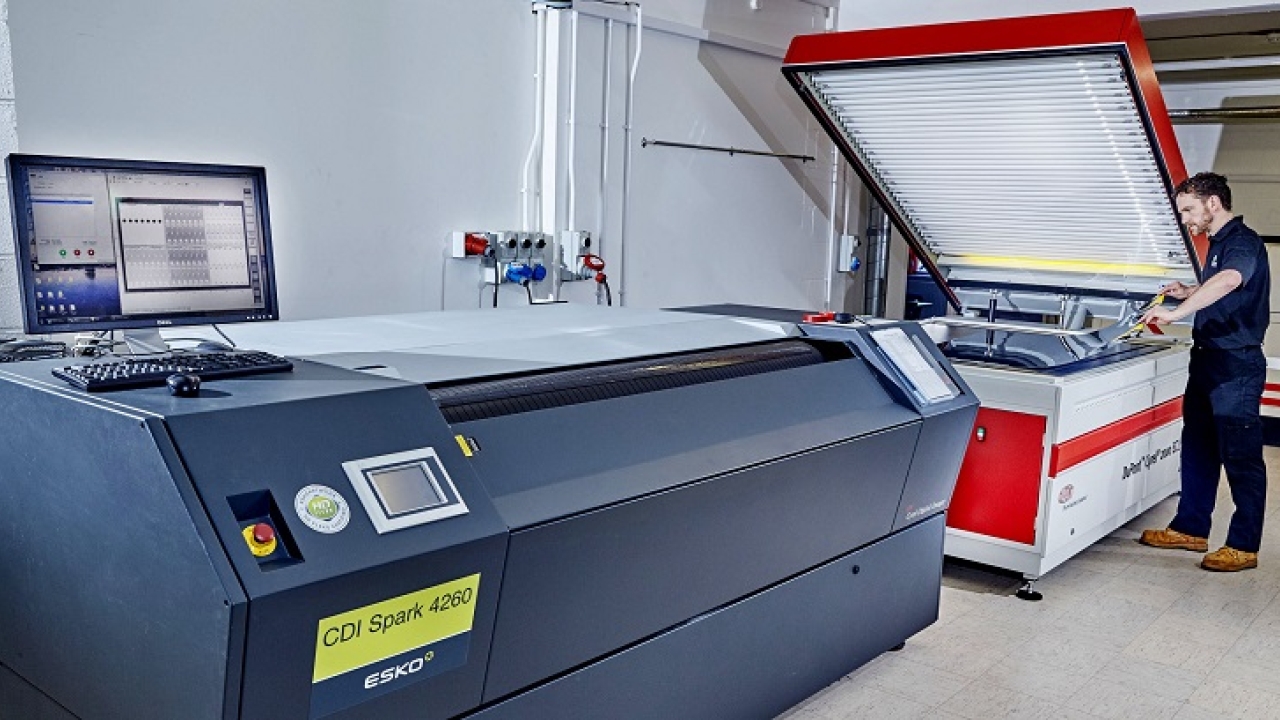Creation gets creative in pre-press

UK-based Creation Reprographics is investing in the latest systems and technology to deliver consistent, high quality performance for its clients through packaging artwork, reprographics and plate production.
The company was founded in 2004 by Matt Francklow, who after more than a decade working in the flexible packaging industry took the step to set up the business off his own back. Now a 24/7 operation, Creation operates across the food and beverage, personal and home care, horticulture and pharmaceutical markets. It serves customers producing labels, folding cartons, rigid and flexible packaging. Labels account for around 80 percent of its business today.
To keep up with the demands of modern label printing, Francklow has sought to bring in the latest pre-press and platemaking technologies in order to push forward Creation’s production, as well as that of its customers. New hardware, consumables and software have all been invested in, while the introduction of an overall equipment effectiveness (OEE) strategy has helped fine tune all areas of productivity.
Going solvent-free
In support of this, Creation has introduced Asahi Photoproducts’ AWP water-washable flexo plates.
‘We started with basic solvent plates, then progressed to DuPont Cyrel Fast,’ notes Francklow. Cyrel Fast is a solvent-free, dry thermal plate processing system. ‘Now we supply Asahi AWP-DEF/DEW water-washable plates, which offer better quality and are better for the environment. AWP-DEW is also up to four times faster to process.’
Asahi’s AWP water-washable plate technology removes the need for high temperatures or VOC solvents in the washout process, delivering precise plate-to-plate registration with reduced odor in the platemaking process. Further benefits claimed of the technology are: reduced make-ready with fast run-up to color due to dot stability and predictability; a reduction in production time of 33 percent compared to solvent-based platemaking; five-minute drying time at a low temperature; and plate stability due to the low temperature production process.
Francklow is working to transition all of the company’s plate production to such modern processes and remove the use of solvents. This has been helped by the breakdown of Creation’s solvent platemaking system.
‘Fast and AWP are the two solutions I want us to offer. Solvent is a dirty process, the machine takes up a lot of space and there are higher cost of repairs. We don’t want to be using solvent and don’t think our customers do either.’
One such customer to benefit from the introduction of Asahi AWP has been Hamilton Adhesive Labels. Since 2016, the two companies have been collaborating to integrate the technology into the UK printer’s operations.
Paul Larkin, operations director at Hamilton Adhesive Labels, comments: ‘We are extremely impressed with the dot reproduction, repeatable quality and stability of the plate on press. The plate lasts longer. It has much greater durability, reducing the number of times we have to remake a new plate, which of course means less ink and substrate waste and more press up time. We have experienced higher press speeds and improved productivity as a result.’
Beyond plates
As well as producing flexo plates, Creation’s products and services range from design and origination, and color management, to producing dry offset plates and cutting on a Kongsberg table.
The production of rotary screens has been a part of the business for around a decade, although it has received a large focus from the company this year. A unique way of producing screens has been developed, where it can use any end ring, on any press of any size.
Says Francklow: ‘It involved a lot of hard work and heartache, refining and refining. We are there now and supplying customers. We make around 20 screens a day.’
Further, it has signed a three-year deal with Kocher+Beck to exclusively supply its TecScreen material in the UK.
Creation has even refreshed the packing of screens to ensure these delicate components reach customers in optimum condition. This has involved fine tuning of the packing structure, the use of compressed air to create a cushion, drop tests and the recreation of other real-life scenarios screens might encounter during shipping. The new screen packing uses material from deliveries in the flexo operation that is repurposed and reused, providing cost and environmental benefits.
‘Screen sales often serve as a gateway that allow us to gain flexo plate and other repro business,’ notes Francklow.
Software
Software is another route to growth identified by Francklow. Creation has made heavy investments over the last few years, such as in the latest Esko products to streamline and automate its processes. WebCenter 18, a major new release of Esko’s packaging management system, has recently been installed at Creation.
Internal expertise is then used to take an off-the-shelf product and build it into ‘something much more’. A flexible, secure online portal has been created to ensure all pieces of the job are stored and distributed from one organized location. Round-the-clock accessibility means files can be reviewed, annotated and approved at any time and from anywhere. States Francklow: ‘WebCenter now runs our business. Everything goes through it.’
Creation’s team also works to build bridges that allow WebCenter to integrate into its customers MIS and ERP systems. It recently worked on a project to integrate Oracle straight into WebCenter, and can integrate with systems from the likes of Tharsten, Cerm and Label Traxx. In fact, Creation and Label Traxx have embarked on a collaborative project to bring about smart manufacturing through enhanced digital systems. This has seen Label Traxx design and develop an advanced software system that gives customers the ability to send digital print orders to Creation, resulting in an overall leaner production environment. Creation has embedded the Label Traxx system into its own software, CreationLink, a streamlined and automated digital workflow system. This fully integrates all business activities – from artwork to plate production – into a single automated process to deliver enhanced production efficiency and client satisfaction.
Another project has been the development of sophisticated MIS software for KM Packaging, which utilizes Esko WebCenter to deliver a streamlined, automated digital workflow process to enhance production efficiency and increase client satisfaction. Creation worked closely with KM Packaging, a global supplier of packaging and lidding films, to create a bespoke online workflow platform that fully integrates activities into a single automated process. The tailored system has delivered improved turnaround times, optimum operating capacity and 24/7 service for KM Packaging’s worldwide customers. Additionally, by creating full traceability, it has removed the risk of human error that is inherent in a manual workflow process.
Kerry Wilson, print services manager at KM Packaging, says: ‘Since the new platform has been live, we have reduced total turnaround time significantly – from just over two weeks to an average of just five days, which is highly valued in the fast-moving food industry. We can now deliver a fast-track service to our customers, with a turnaround of just 48 hours – exceeding customer expectations.’
Design
However, before artwork approval comes origination. Here, Creation is looking to add additional value by helping small and medium brands work up their ideas into print-ready artwork. To this end, Creation has instigated a series of workshop days where such brands can use the company’s expertise in reprographics and printing to discuss and progress their ideas. This often sees them leave with a color managed proof that matches the specification of the preferred print process.
‘When using a design agency, you might be paying a premium for high-end design work that will end up being unusable when it reaches production. We’ve found that most brands know what they want, within reason, so they benefit from us knowing a lot about the print processes involved. We are someone they can come to with their ideas. Then we play around with all of the concepts and leave them with something tangible that they can use.’
He continues: ‘This all contributes to our work to make our customers’ lives easier, to streamline interactions across the pre-press environment.
‘Streamlining workflows benefits us and our customers, and their customers. We want to give them everything needed to help them be the best that they can be.’
Stay up to date
Subscribe to the free Label News newsletter and receive the latest content every week. We'll never share your email address.


